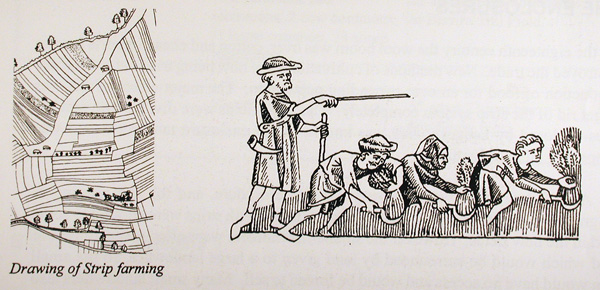
FARMING IN SULGRAVE: EARLY HISTORY
(Back to Chapter 1 Index)
STRIP FARMING
From medieval times Sulgrave, like most villages in England, was farmed on the strip culture method. The Parish was divided into three large fields - Magpie Field, Barrow Hill Field and Stuchbury Field. All villagers were entitled to farm land in the form of narrow strips in each field. These strips were not together, but scattered throughout the fields. This ensured that everyone had a fair share of different quality farming land. The strips, which were roughly the width of a horse drawn plough, were grouped into Furlongs - of 220 yards in length. Such Furlongs had names, Sulgrave being made up of Farr, Thruphedge, Barrow Hill, Hollowell, Town, Inmead, Stambridge and Stuchbury Hedge Furlongs.

Clear evidence of these strips can be seen in the 'ridge and furrow' topography to be seen in many of the fields in Sulgrave that have not been regularly ploughed in modern times.
Common land was also available from which to gather wood and on which to graze animals. The concept of such farming was self-sufficiency.
Strip farming was an inefficient method as animals were free to wander over the unfenced field, lazy 'neighbours' could lead to the ruin of much hard labour and time was wasted travelling from one strip to another.
WOOLSTAPLING
By Tudor times economic forces had led to a much more commercial approach to farming. The more wealthy villagers were buying out the strips of the poorer ones and becoming yeoman farmers, producing for a market, not just self-sufficiency.
England had long been famous for its cloth, and cloth meant wool, and wool sheep. With the dissolution of the monasteries even more land became available to the well-to-do merchant or yeoman farmer, who now realized the potential of sheep farming. Lawrence Washington purchased the Manors of Sulgrave and Stuchbury with the intention of 'exploiting the land primarily for sheep'. In fact his son Robert, in collaboration with his cousins, George Mole and Robert Pargeter, continued to exploit the land for kine and sheep and, 'scandalously pulled down not only the parsonage house and all or most of the said town and parish houses of Stuchbury aforesaid, also the Parish Church itself, to make use of the land for woolstapling purposes'. The villagers became vagrants on the roads or went to the local towns to find work. Thus, much of Sulgrave would have been put down to sheep pasture.
THE ENCLOSURES
By the eighteenth century the wool boom was over, cotton and cheap imports having destroyed the trade, new methods of cultivation were now being tried out to increase production of food for an ever-expanding population. The major effect of this was to get rid of the strip system completely. The large fields were divided into smaller ones enclosed by hedges. This was known as the enclosure movement and was happening all over England.
An Act of Parliament was necessary for this procedure, and the one relating to Sulgrave was passed in 1761. In theory all villagers with strips were entitled to some land in the new fields. However the smaller freeholders were often given a peice of land which would be surrounded by land given to a large landowner, so the small man would have no access and would be forced to sell. Many small landowners also did not have the cash to fence in their new grants of land within the stipulated time, thus again were forced to sell.
Gradually all the new fields came to be owned by a very few farmers and the majority of villagers had nowhere to grow crops or graze animals. Thus they became farm labourers instead of independent landowners. The enclosures led to a more efficient agricultural system with more food being produced for the ever growing cities, but the rural working man lost his independence and had to work long hours for poor pay.
Sulgrave Manor has a full copy of the Sulgrave Enclosure Award of 1761 from which the following are sample awards.
| Holding in Common Field | Area Alloted in Lieu | |
|---|---|---|
| Rev. Wm Wykham | 2 yardlands and common small and vicarial tithes. | 105 acres 21 perches in Magpie Field. |
| Edward Brockliss | 1/2 yardlands lately bought from Wm. Graves, also odd pieces of land and One Horse Common and 1/2 yardland with commons. | A piece of Old Enclosure and Watermill. 9 acres 1 rod and 15 perches in Magpie Field. |
| Thos. Wilcox | 1/2 yardlands and commons. | 8 acres 3 rods 16 perches in Barrow Hill Field. |
| Christopher Cook | 1/2 yardlands and commons, 2 cow commons, 1 horse common, 24 sheep commons. | 23 acres 3 rods 35 perches in Barrow Hill Field. |
| John Buswell | 2 yardlands and commons. | 57 acres 23 perches in Stuchbury Field. |
STOCK FATTENING
Until the abnormal conditions produced by Common Market subsidies, Sulgrave, like most of Northamptonshire, had basically been a pastoral parish. The fattening of cattle for the market in Banbury, still the largest stock market in Europe, had been the mainstay of the farming economy throughout the nineteenth and early twentieth centuries. This activity, judiciously balanced with sheep and pig production, enabled Sulgrave to support no fewer than 16 farms, most having the fronts on the road with their lands extending out behind them.